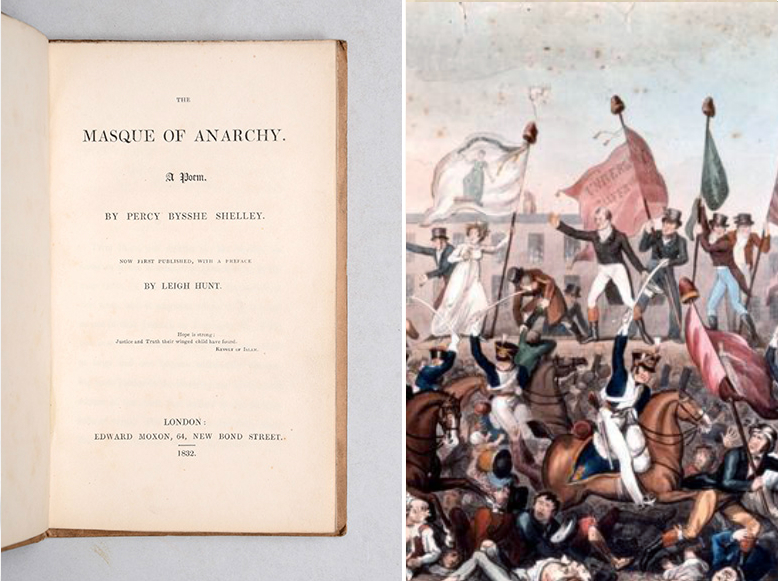
“Ye Are Many”: The Literature of Protest
During a speech in 1965, Martin Luther King said that “Our lives begin to end the day we become silent about things that matter.” The recent celebration of Martin Luther King Day, coupled with the weekend’s demonstrations – which saw millions of people worldwide undertake peaceful marches in the wake of the US Presidential inauguration – have got us thinking about the nature of protest and dissent. Literature has, of course, historically played a significant part in influencing social and political change. This list is dedicated to the literature of protest and the writers who did not hold their silence in the face of perceived injustice, inequality and abuses of power.

THOMPSON, William, [& Anna Wheeler]. Appeal of One Half the Human Race, Women, Against the Pretensions of the Other Half, Men. London: Longman, Hurst, Rees, Orme, Brown, and Green, and Wheatley and Adlard, 1825.
Anna Wheeler (née Doyle) by Maxim Gauci, printed by Charles Joseph Hullmandel, after J. Porter lithograph, published 1825? National Portrait Gallery
Though she was unedited as a collaborator, Anna Wheeler, British writer and advocate of women’s rights, was referred to by William Thompson as the joint owner of this volume. Thompson was an Irish political activist, Chartist and social reformer. Provoked by James Mill’s dismissal of the need for women’s suffrage in his Article on Government, in which he argued that women’s interests could be adequately represented by their husbands and fathers, Thompson and Wheeler produced their Appeal which laid out their argument for the granting of equal political rights to women. The Oxford Dictionary of National Biography refers to this as “one of the classics of early nineteenth-century feminist literature”.
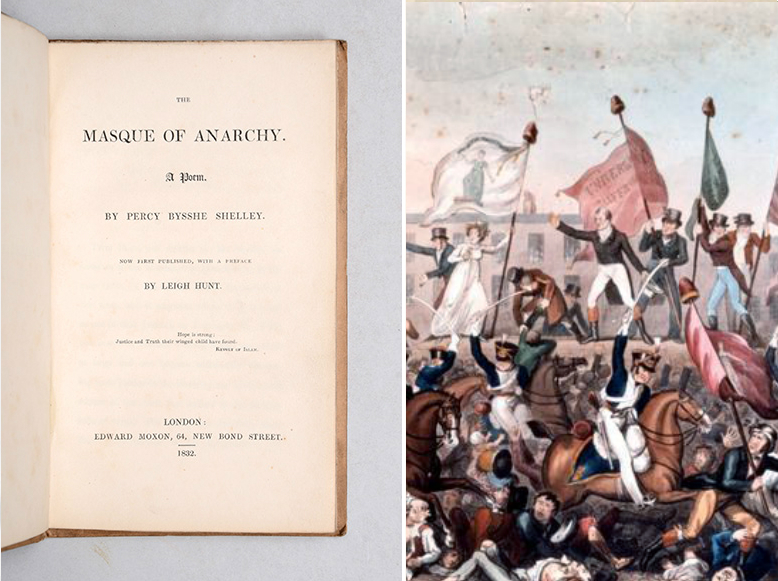
SHELLEY, Percy Bysshe. The Masque of Anarchy. A Poem. London: Edward Moxon, 1832.
Engraving of the Peterloo Massacre by Richard Carlile (1790–1843) (Manchester Library Services)
Percy Bysshe Shelley, The Masque of Anarchy, 1832 – BOOK SOLD
Sometimes called the greatest political poem in the English language, Shelley’s Masque remained unpublished until 1832, ten years after his death. It was written, however, in 1819 as a direct response to the Peterloo Massacre, during which cavalry charged a protest of 60,000 people who had gathered to demand parliamentary reform. In its exhortation for people to assemble peacefully in protest against unjust authority, Shelley’s poem is one of the first treatises on nonviolent resistance and inspired Henry David Thoreau in his essay Civil Disobedience, and later Gandhi’s doctrine of Satyagraha. The rallying cry “Ye are many, they are few” has been taken up by protests all over the world – often adapted as “we are many, they are few” – and was chanted by 19th century Chartists , by striking women garment workers in 1909 New York, at demonstrations in Tiananmen Square in 1989 and at the Egyptian revolution in Tahrir Square in 2011.
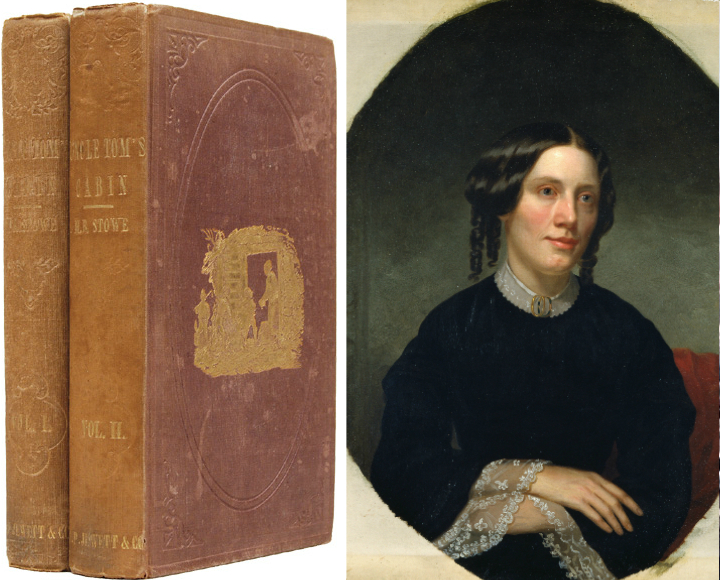
STOWE, Harriet Beecher. “Uncle Tom’s Cabin; or, Life Among the Lowly.” Boston: John P. Jewett & Co., 1852.
Harriet Elizabeth by Alanson Fisher, 1853, National Portrait Gallery.
Harriet Beecher Stowe, Uncle Tom’s Cabin; or, Life Among the Lowly, 1852 – BOOK SOLD
Top of FormStowe’s story of the life of a black slave is one of the most influential anti-slavery texts ever published. Originally appearing in serial form in the abolitionist newspaper The National Era, it was soon published in two volumes by Boston publisher John P. Jewett & Co. and was an instant best-seller. It is credited with having brought home the realities of slavery to thousands of Americans, and with fuelling the popular abolitionist movements of the 1850s. Stowe was a teacher and author whose Christian background had led her to abhor the exploitation of human lives, and she used her platform of relative privilege to influence the opinions of others. “I hope every woman who can write will not be silent” she wrote in a letter to the editor of National Era in 1850. In Printing and the Mind of Man (1967), the social impact of Uncle Tom’s Cabin if referred to as “greater than that of any book before or since.”

SINCLAIR, Upton. The Jungle. New York: The Jungle Publishing Co., 1906.
Floorers removing the hides USY Chicago, Suhling & Koehn Co.
Upton Sinclair, The Jungle, 1906 – BOOK SOLD
Sinclair’s famously misinterpreted novel aimed to expose the terrible working conditions of immigrant workers in America’s food packing industry, but proved much more successful at inciting reform of unsanitary practices than addressing the issue of wage slavery. Sinclair said of the public reaction “I aimed at the public’s heart, and by accident I hit it in the stomach.”
Nevertheless, Sinclair’s depiction of working class poverty and its link to corruption amongst the powerful remains a searing and important indictment of the exploitation of the vulnerable in the name of capitalist gain.
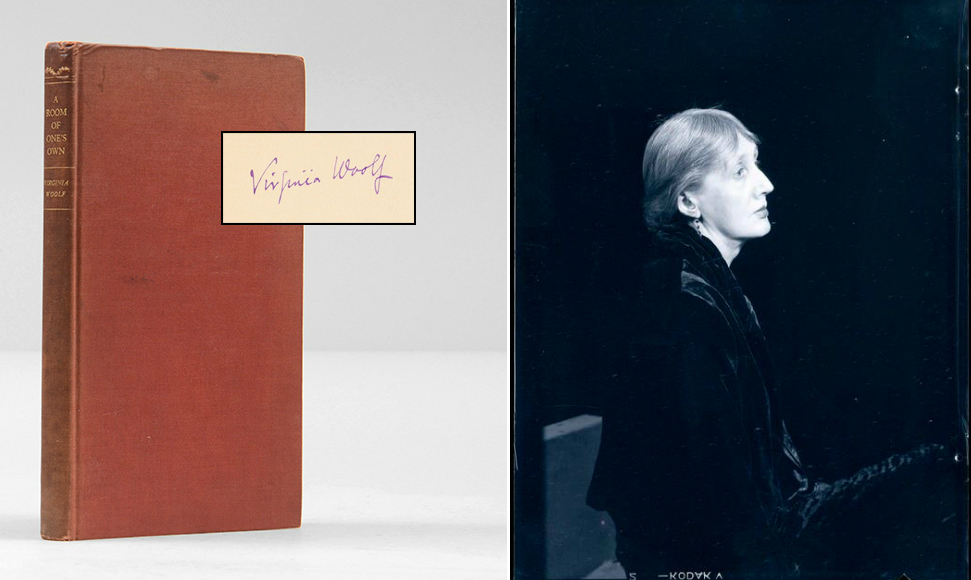
WOOLF, Virginia. A Room of One’s Own. New York: The Fountain Press; London: The Hogarth Press, 1929.
Portrait of Virginia Woolf, Man Ray, 1934.
Virginia Woolf, A Room of One’s Own, 1929 – BOOK SOLD
Very little needs to be added to the existing body of cultural appreciation for Woolf’s seminal feminist text. Her observations about the patriarchal literary culture and the sometimes insurmountable practical challenges women had to overcome in order to pursue a writing career helped challenge the then widely-held view that women had enjoyed less literary success because they were inherently inferior writers to men. She ended her essay by appealing to her audience “to write all kinds of books, hesitating at no subject however trivial or however vast.” This first edition is signed by Woolf on the half-title.

ELLISON, Ralph. Invisible Man. New York: Random House, 1952.
Ralph Ellison, photographed by United States Information Agency staff photographer, 1961.
Ralph Ellison, Invisible Man, 1952 – BOOK SOLD
Ralph Ellison wrote this novel about a man whose race renders him socially invisible as a reaction to his experience of prejudice and the oppression of black people in America. Its style, experimental and virtuosic, was influenced both by jazz performances Ellison witnessed and by French Existentialist writers such as Albert Camus and Jean-Paul Sartre.
The novel was hailed as a ground-breaking success, admired by writers such as Saul and Bellow Harold Bloom, and spent sixteen weeks on the bestseller list. Despite – or perhaps because of – this success, Ellison never published another novel in his lifetime. Invisible Man remains, however, one of the most important intellectual meditations on black identity and was a primary source of inspiration for Barack Obama’s memoir Dreams from my Father.
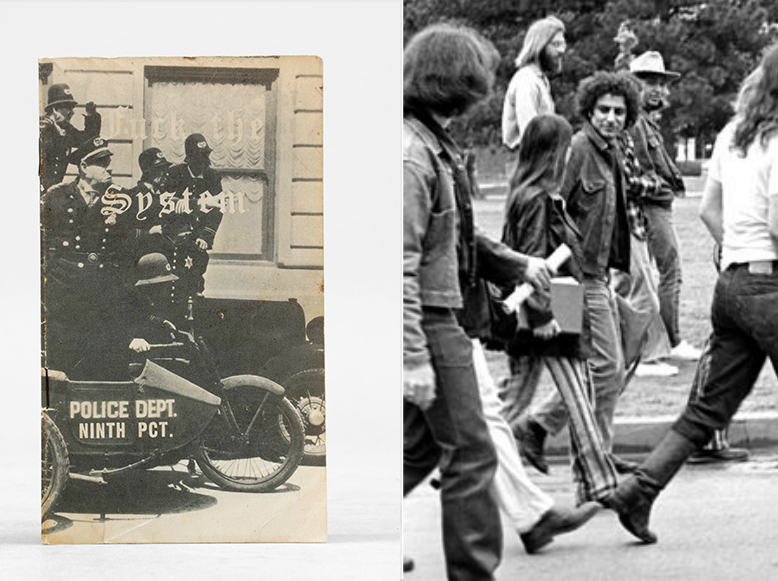
“George Metesky.” Fuck the System. New York: Privately Printed, 1967.
Abbie Hoffman visiting the University of Oklahoma to protest the Vietnam War by Richard O. Barry from San Diego, California, United States
This pamphlet, written by American political activist and anarchist Abbot ‘Abbie’ Hoffman, functioned as a guidebook to living for free in New York City. From counterfeiting subway tickets to dumpster-diving for free food, Fuck the System is an artefact of 60s subculture which focussed on flying under the radar. The pseudonym George Metesky was taken from the so-called ‘Mad Bomber’ who had terrorised New York throughout the 40s and 50s with bombs planted about the city. Hoffman was the founder of the Youth International party (commonly called the ‘Yippies’), an influential anti-war countercultural group in the 60s who used street theatre and pranks to exploit mass media coverage and spread their message.

Recent Comments